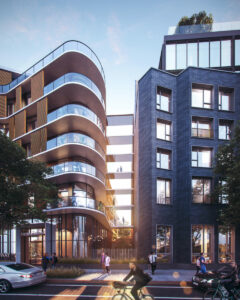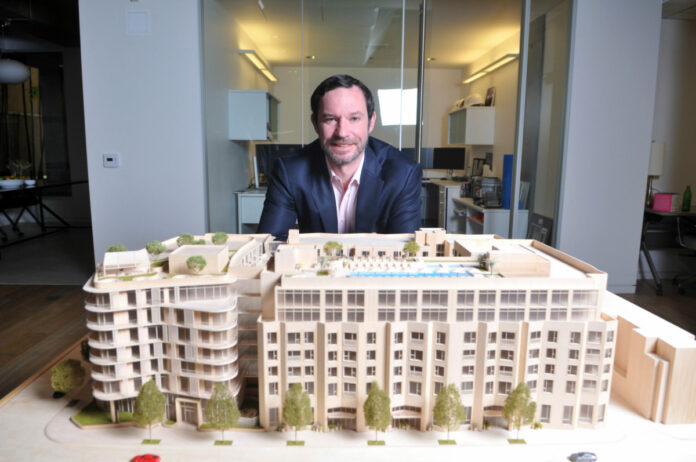Despite concerns over rising construction costs and future marketplace trends, some real estate developers are moving full speed ahead with large-scale mixed-use projects.
Take Related California. The company recently scored $385 million in construction financing from Bank of America for its 710 Broadway project in Santa Monica, which will have both apartment units and a retail component.
Gino Canori, president of Related California, said the company has worked with Bank of America for more than 25 years and, despite a difficult time for lending, the bank “stepped up. They believed in it.”
Canori called the project a “huge game changer in the city.”
“We consider this one of the best locations in Santa Monica for a mixed-use project,” he added.
The project, designed by Pico-Robertson-based Large Architecture with interiors from Sawtelle-based Marmol Radziner and landscaping by Boyle Heights-based Studio-MLA, will have 280 apartments in addition to retail space.
Of those units, 70% will be market-rate, while 20% will be affordable units and 10% will be middle-income housing. Rents for the market-rate units are not yet available.
“We have a long history in Santa Monica. This project fits what our goals are in terms of providing mixed-income housing, being in a first-class market like Santa Monica and being large enough in scale,” said Larry Wilkes, vice president at Related California.
Related has partnered with Santa Monica-based nonprofit Community Corporation of Santa Monica on the affordable units. The nonprofit builds and manages affordable housing units.
“They’ve done tons of projects and we have partnered with them in the past,” Canori said. “Anytime we have a mixed-income project, we bring in a local nonprofit to partner with. We have a great relationship with them and turned to them to be our partner.”
“In California, we are in a housing shortfall at all income levels,” he added. “They do a great job on the Westside, but it’s hard for them to get very large projects like we can do. By partnering (with us), they are able to expand their footprint.”
Amenities will include a large amount of outdoor space, a lap pool, a fitness center, a coworking space and a bowling alley.
The project is expected to break ground in March and wrap up by the end of 2025.
Retail
The project will also feature a 30,000-square-foot park, 35,000 square feet of retail and a 55,000-square-foot Vons grocery store.
Canori said it was a benefit to have a grocer in the building and expects the additional retail space to be leased shortly.
Experts and developers agree that retail has fared better in Santa Monica than in other areas in the county.
Santa Monica is a very desirable market for all retailers or most retailers.
SEAN FULP
Colliers
“Santa Monica has always been one of the strongest markets on the Westside for retail,” Canori said. “We have been successful in the market in the past. What we’re seeing now is a consolidation of certain retailers to what they believe to be the best projects (like ours). There’s a flight to quality.”
Sean Fulp, vice chair and head of capital markets at Colliers, and a Santa Monica resident, agreed that the city was viewed favorably.
“Santa Monica is a very desirable market for all retailers or most retailers. You have new concepts that are continuing to be tested out in markets like Santa Monica before they are rolled out nationwide,” Fulp said
He added that large projects with a retail component in the city “aren’t having any issues at all” leasing; in fact, Fulp said he expects them to be pre-leased.
The vacancy rate during the fourth quarter in Santa Monica was 13.2%. Rent was $5.60 a square foot, compared with $2.99 countywide, according to data from Jones Lang LaSalle Inc.
Greg Briest, a senior vice president at JLL, said there was some “ramp-up occurring now” in the area, adding that Arte Museum signing on to 48,000 square feet at Santa Monica-based Macerich Co.’s Santa Monica Place, taking over the former ArcLight Cinemas location, as well as a Gold’s Gym and other leases, “are important dominoes to fall.”
He said the area is seeing more demand for second-generation restaurant space as opposed to soft-good retail shops.
Other development
Related isn’t the only company interested in the city.
“Santa Monica is considered a core market,” Fulp said. “There’s always investor interest in the market across all property types. No different than other downtown districts, Santa Monica’s downtown district is struggling from the same issues others are, and that impacts foot traffic and sales and office tenants being able to encourage employees back to the office, but it’s not as extreme as what you’ve seen (elsewhere).”
One major project in the area comes from New York-based Basis Investment Group and Tishman Speyer Properties. Basis last month announced that it invested $30 million into The Santa Monica Collection, an eight-building project led by Tishman Speyer. Once completed, the project will feature 617 residential units. (To learn more about the project, see Page 4.)
“We are pleased to be partnering with Basis Investment Group to cultivate a thriving mixed-use community in the heart of downtown Santa Monica,” Rob Speyer, chief executive of Tishman Speyer, said in a statement.
Other developers, such as Santa Monica-based WS Communities, Brentwood-based Cypress Equity Investments and Century City-based LaTerra Development, are also investing in the area.
In March, the Santa Monica’s Planning Commission told the city that in order to receive certification from the California Department of Housing and Community Development, the city needed to increase housing density. Penalties can be levied for noncompliance.

Failure to certify resulted in a “builder’s remedy” window in which the city lost control over zoning rules. The City Council has since approved a revised housing plan, and it was certified by the state late last year.
The city is now looking to develop more housing and has “opened up opportunities and we have property owners looking at sites as coveted investment sites or development sites,” Fulp said.

